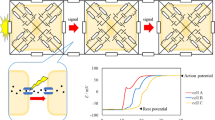Abstract
In this paper we introduce and study a model for electrical activity of cardiac membrane which incorporates only an inward and an outward current. This model is useful for three reasons: (1) Its simplicity, comparable to the FitzHugh-Nagumo model, makes it useful in numerical simulations, especially in two or three spatial dimensions where numerical efficiency is so important. (2) It can be understood analytically without recourse to numerical simulations. This allows us to determine rather completely how the parameters in the model affect its behavior which in turn provides insight into the effects of the many parameters in more realistic models. (3) It naturally gives rise to a one-dimensional map which specifies the action potential duration as a function of the previous diastolic interval. For certain parameter values, this map exhibits a new phenomenon—subcritical alternans—that does not occur for the commonly used exponential map.
Similar content being viewed by others
References
Banville, I. and R. Gray (2002). Effect of action potential duration and conduction velocity restitution and their spatial dispersion on alternans and the stability of arrhythmias. J. Cardiovasc. Electrophysiol. 13, 1141–1149.
Beeler, G. and H. Reuter (1977). Reconstruction of the action potential of ventricular myocardial fibres. J. Physiol. (Lond.) 268, 177–210.
Bender, C. and S. Orszag (1978). Advanced Mathematical Methods for Scientists and Engineers, McGraw-Hill.
Boyett, M. and D. Fedida (1984). Changes in the electrical activity of dog cardiac Purkinje fibres at high heart rates. J. Physiol. 350, 361–391.
Euler, D. (1999). Cardiac Alternans: Mechanisms and pathophysiological significance. Cardiovasc. Res. 42, 583–590.
Fenton, F. and A. Karma (1998). Vortex dynamics in three-dimensional continuous myocardium with fiber rotation: Filament instability and fibrillation. Chaos 8, 20–47.
FitzHugh, R. (1960). Thresholds and plateaus in the Hodgkin-Huxley nerve equations. J. Gen. Physiol. 43, 867–896.
FitzHugh, R. (1961). Impulse and physiological states in models of nerve membrane. Biophys. J. 1, 445–466.
Gilmour, R., N. Otani and M. Watanabe (1997). Memory and complex dynamics in cardiac Purkinje fibers. Am. J. Physiol. 272, 1826–1832.
Glass, L. and M. Mackey (1988). From Clocks to Chaos: The Rhythms of Life, Princeton University Press.
Golubitsky, M. and D. Schaeffer (1985). Singularities and Groups in Bifurcation Theory, Vol. I, Springer.
Guevara, M., M. Ward, A. Shrier and L. Glass (1984). Electrical alternans and period-doubling bifurcations. Comput. Cardiology 167–170.
Hall, G. M., S. Bahar and D. Gauthier (1999). Prevalence of rate-dependent behaviors in cardiac muscle. Phys. Rev. Lett. 82, 2995–2998.
Karma, A. (1993). Spiral breakup in model equations of action potential propagation in cardiac tissue. Phys. Rev. Lett. 71, 1103–1106.
Karma, A. (1994). Electrical alternans and sprial wave breakup in cardiac tissue. Chaos 4, 461–472.
Kevorkian, J. and J. Cole (1981). Perturbation Methods in Applied Mathematics, Springer.
Luo, C. and Y. Rudy (1991). A model of the ventricular cardiac action potential. Circ. Res. 68, 1501–1526.
Luo, C. and Y. Rudy (1994). A dynamic model of the cardiac ventricular action potential. Circ. Res. 74, 1071–1096.
Noble, D. (1960). Cardiac action and pacemaker potentials based on the Hodgkin-Huxley equations. Nature 188, 495–497.
Noble, D. (1962). A modification of the Hodgkin-Huxley equations applicable to purkinje fibre action potentials. J. Physiol. 160, 317–352.
Nolasco, J. and R. Dahlen (1968). A graphic method for the study of alternation in cardiac action potentials. J. Appl. Physiol. 25, 191–196.
Strogatz, S. (1994). Nonlinear Dynamics and Chaos, Addison Wesley.
Tolkacheva, E., D. Schaeffer, D. Gauthier and C. Mitchell (2002). Analysis of the Fenton-Karma model through approximation by a one dimensional map. Chaos 12, 1034–1042.
Winfree, A. (1987). When Time Breaks Down: The Three-Dimensional Dynamics of Electrochemical Waves and Cardiac Arrhythmias, Princeton University Press.
Author information
Authors and Affiliations
Rights and permissions
About this article
Cite this article
Mitchell, C.C., Schaeffer, D.G. A two-current model for the dynamics of cardiac membrane. Bull. Math. Biol. 65, 767–793 (2003). https://doi.org/10.1016/S0092-8240(03)00041-7
Received:
Accepted:
Issue Date:
DOI: https://doi.org/10.1016/S0092-8240(03)00041-7




